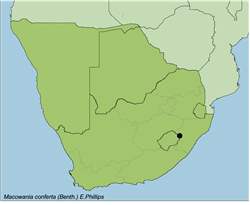Names and synonyms
Macowania conferta (Benth.) Phillips
=Homochaete conferta Benth.
Type
Sutherland, P.C., [Pondoland] Faku's Territory (K; fragment PRE).
Derivation of names
Macowania = after Dr. Peter MacOwan (1830-1901), botanist, director of the Cape Town Botanic Gardens, and discoverer of new species at the Cape.
conferta = crowded, packed close together
Diagnostic characters
Leaves glossy above, glandular on both surfaces, not woolly-hairy below
Corolla of disc florets hairy immediately below the expanded upper part.
Leaves are less viscid and more glandular than in M. sororis.
Capitula sessile
Anther tails free and fimbriate.
Pappus bristles about 17, equalling the corolla
Description
Dwarf, much-branched shrub forming low, compact cushions. Stems densely leafy when young. Leaves dark green, glossy, closely imbricated, linear, abruptly acute, up to 15 x 2 mm, margins strongly revolute, both surfaces glandular-pilose, not woolly below, midrib strongly raised below. Capitula sessile, solitary at the branch tips, 20 mm diam, rays bright yellow, disc florets darker. Involucre funnel-shaped, c. 12 x 10-12 mm. Involucral bracts pale brown or straw-coloured, lightly woolly, minutely glandular. Ray florets yellow, female. Disc florets hermaphrodite; corolla narrowly cylindric below widening gradually above, with a few hairs immediately below the expanded part. Cypselas 10-ribbed, c. 3-5 mm long, pilose. Pappus bristles about 17, barbed, subequal, the longest equalling the corolla of disc flowers, persistent.
Flowering time
Recorded in January.
Distribution
Only known from two localities in Pondoland: on Ngeli Mt and from "Faku's territory" which included the western side of Ngeli Mt., and from the Bergville Dist. at Ndedema
Habitat
On rock outcrops on steep grassy mountain slopes at about 1800 m.
Notes
M. conferta resembles M. sororis. Leaves of M. sororis are woolly below, more viscid and less glandular, and the heads are shortly pedunculate, corola of disc florets without hairs.
References
ANDERBERG, A.A. 1991. Taxonomy and phylogeny of the tribe Gnaphalieae (Asteraceae). Opera Botanica 104: 50-53.
GLEN, H.F. 2004. SAPPI, What's in a Name? The Meanings of the Botanical Names of Trees. Jacana.
HILLIARD, O.M. & BURTT, B.L. 1970.Notes on some plants of southern Africa chiefly from Natal: I. Notes from the Royal Botanic Garden Edinburgh 30: 123.
HILLIARD, O.M. & BURTT, B.L. 1976. Notes on some plants of southern Africa chiefly from Natal: V. Notes from the Royal Botanic Garden Edinburgh 34,3: 260-276.
HILLIARD, O.M. 1977. Compositae in Natal. University of Natal Press.
KESTING, D. & CLARKE, H. 2008. Botanical names, what they mean. Wild Flowers of the Cape Peninsula, 3rd revised edition. Friends of Silvermine.
PHILLIPS, E.P. 1950. Descriptions and changes of names. Journal of South African Botany 16: 21
